[English] 日本語
 Yorodumi
Yorodumi- PDB-5i58: GLUTAMATE- AND GLYCINE-BOUND GLUN1/GLUN2A AGONIST BINDING DOMAINS... -
+ Open data
Open data
- Basic information
Basic information
| Entry | Database: PDB / ID: 5i58 | ||||||
|---|---|---|---|---|---|---|---|
| Title | GLUTAMATE- AND GLYCINE-BOUND GLUN1/GLUN2A AGONIST BINDING DOMAINS WITH MPX-004 | ||||||
 Components Components | (Glutamate receptor ionotropic, NMDA ...) x 2 | ||||||
 Keywords Keywords | TRANSPORT PROTEIN / RECEPTOR / NMDA receptor / Antagonist | ||||||
| Function / homology |  Function and homology information Function and homology informationneurotransmitter receptor transport, plasma membrane to endosome / regulation of response to alcohol / response to ammonium ion / receptor recycling / response to environmental enrichment / directional locomotion / positive regulation of Schwann cell migration / pons maturation / regulation of cell communication / EPHB-mediated forward signaling ...neurotransmitter receptor transport, plasma membrane to endosome / regulation of response to alcohol / response to ammonium ion / receptor recycling / response to environmental enrichment / directional locomotion / positive regulation of Schwann cell migration / pons maturation / regulation of cell communication / EPHB-mediated forward signaling / Assembly and cell surface presentation of NMDA receptors / response to hydrogen sulfide / auditory behavior / olfactory learning / conditioned taste aversion / dendritic branch / regulation of respiratory gaseous exchange / response to other organism / regulation of ARF protein signal transduction / protein localization to postsynaptic membrane / cellular response to magnesium ion / serotonin metabolic process / transmitter-gated monoatomic ion channel activity / positive regulation of inhibitory postsynaptic potential / response to methylmercury / suckling behavior / response to manganese ion / response to glycine / response to carbohydrate / propylene metabolic process / sleep / dendritic spine organization / locomotion / cellular response to dsRNA / regulation of NMDA receptor activity / cellular response to lipid / RAF/MAP kinase cascade / regulation of monoatomic cation transmembrane transport / NMDA glutamate receptor activity / Synaptic adhesion-like molecules / voltage-gated monoatomic cation channel activity / response to glycoside / NMDA selective glutamate receptor complex / glutamate binding / ligand-gated sodium channel activity / neurotransmitter receptor complex / response to morphine / glutamate receptor signaling pathway / regulation of axonogenesis / neuromuscular process / calcium ion transmembrane import into cytosol / regulation of dendrite morphogenesis / protein heterotetramerization / male mating behavior / regulation of synapse assembly / spinal cord development / response to amine / glycine binding / cellular response to zinc ion / startle response / parallel fiber to Purkinje cell synapse / positive regulation of reactive oxygen species biosynthetic process / dopamine metabolic process / monoatomic cation transmembrane transport / response to lithium ion / positive regulation of calcium ion transport into cytosol / cellular response to glycine / modulation of excitatory postsynaptic potential / response to light stimulus / regulation of postsynaptic membrane potential / action potential / associative learning / conditioned place preference / excitatory synapse / positive regulation of dendritic spine maintenance / monoatomic ion channel complex / social behavior / monoatomic cation transport / regulation of neuronal synaptic plasticity / glutamate receptor binding / positive regulation of protein targeting to membrane / Unblocking of NMDA receptors, glutamate binding and activation / positive regulation of excitatory postsynaptic potential / long-term memory / neuron development / synaptic cleft / phosphatase binding / prepulse inhibition / positive regulation of synaptic transmission, glutamatergic / multicellular organismal response to stress / postsynaptic density, intracellular component / monoatomic cation channel activity / response to fungicide / calcium ion homeostasis / glutamate-gated receptor activity / regulation of neuron apoptotic process / cell adhesion molecule binding / cellular response to manganese ion / glutamate-gated calcium ion channel activity / presynaptic active zone membrane Similarity search - Function | ||||||
| Biological species |  | ||||||
| Method |  X-RAY DIFFRACTION / X-RAY DIFFRACTION /  SYNCHROTRON / SYNCHROTRON /  MOLECULAR REPLACEMENT / Resolution: 2.52 Å MOLECULAR REPLACEMENT / Resolution: 2.52 Å | ||||||
 Authors Authors | Mou, T.-C. / Sprang, S.R. / Hansen, K.B. | ||||||
| Funding support |  United States, 1items United States, 1items
| ||||||
 Citation Citation |  Journal: Neuron / Year: 2016 Journal: Neuron / Year: 2016Title: Structural Basis for Negative Allosteric Modulation of GluN2A-Containing NMDA Receptors. Authors: Yi, F. / Mou, T.C. / Dorsett, K.N. / Volkmann, R.A. / Menniti, F.S. / Sprang, S.R. / Hansen, K.B. | ||||||
| History |
|
- Structure visualization
Structure visualization
| Structure viewer | Molecule:  Molmil Molmil Jmol/JSmol Jmol/JSmol |
|---|
- Downloads & links
Downloads & links
- Download
Download
| PDBx/mmCIF format |  5i58.cif.gz 5i58.cif.gz | 125.1 KB | Display |  PDBx/mmCIF format PDBx/mmCIF format |
|---|---|---|---|---|
| PDB format |  pdb5i58.ent.gz pdb5i58.ent.gz | 95.3 KB | Display |  PDB format PDB format |
| PDBx/mmJSON format |  5i58.json.gz 5i58.json.gz | Tree view |  PDBx/mmJSON format PDBx/mmJSON format | |
| Others |  Other downloads Other downloads |
-Validation report
| Summary document |  5i58_validation.pdf.gz 5i58_validation.pdf.gz | 753.9 KB | Display |  wwPDB validaton report wwPDB validaton report |
|---|---|---|---|---|
| Full document |  5i58_full_validation.pdf.gz 5i58_full_validation.pdf.gz | 766 KB | Display | |
| Data in XML |  5i58_validation.xml.gz 5i58_validation.xml.gz | 23.4 KB | Display | |
| Data in CIF |  5i58_validation.cif.gz 5i58_validation.cif.gz | 31.5 KB | Display | |
| Arichive directory |  https://data.pdbj.org/pub/pdb/validation_reports/i5/5i58 https://data.pdbj.org/pub/pdb/validation_reports/i5/5i58 ftp://data.pdbj.org/pub/pdb/validation_reports/i5/5i58 ftp://data.pdbj.org/pub/pdb/validation_reports/i5/5i58 | HTTPS FTP |
-Related structure data
| Related structure data | 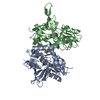 5i56C 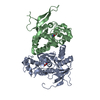 5i57C 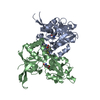 5i59C 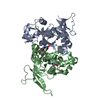 5jtyC  4nf8S C: citing same article ( S: Starting model for refinement |
|---|---|
| Similar structure data |
- Links
Links
- Assembly
Assembly
| Deposited unit | 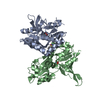
| ||||||||
|---|---|---|---|---|---|---|---|---|---|
| 1 |
| ||||||||
| Unit cell |
|
- Components
Components
-Glutamate receptor ionotropic, NMDA ... , 2 types, 2 molecules AB
| #1: Protein | Mass: 33340.031 Da / Num. of mol.: 1 Source method: isolated from a genetically manipulated source Source: (gene. exp.)   |
|---|---|
| #2: Protein | Mass: 31533.053 Da / Num. of mol.: 1 Source method: isolated from a genetically manipulated source Source: (gene. exp.)   |
-Non-polymers , 4 types, 92 molecules 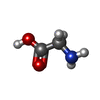
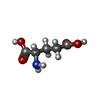
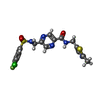




| #3: Chemical | ChemComp-GLY / |
|---|---|
| #4: Chemical | ChemComp-GLU / |
| #5: Chemical | ChemComp-67R / |
| #6: Water | ChemComp-HOH / |
-Details
| Has protein modification | Y |
|---|---|
| Sequence details | The sequence corresponds to the NCBI Reference Sequence NP_036705.3 for GluN2A. residue Thr242 in ...The sequence corresponds to the NCBI Reference Sequence NP_036705.3 for GluN2A. residue Thr242 in this sequence is a Ser758 in Swiss-Prot Q00959. |
-Experimental details
-Experiment
| Experiment | Method:  X-RAY DIFFRACTION / Number of used crystals: 1 X-RAY DIFFRACTION / Number of used crystals: 1 |
|---|
- Sample preparation
Sample preparation
| Crystal | Density Matthews: 2.2 Å3/Da / Density % sol: 44.03 % |
|---|---|
| Crystal grow | Temperature: 273 K / Method: vapor diffusion, hanging drop / Details: 0.2 M ammonium sulfate and 16-22% PEG 4000 |
-Data collection
| Diffraction | Mean temperature: 100 K |
|---|---|
| Diffraction source | Source:  SYNCHROTRON / Site: SYNCHROTRON / Site:  APS APS  / Beamline: 17-ID / Wavelength: 1 Å / Beamline: 17-ID / Wavelength: 1 Å |
| Detector | Type: DECTRIS PILATUS3 6M / Detector: PIXEL / Date: Dec 7, 2015 / Details: Miniquad Collimators |
| Radiation | Monochromator: Si(111) / Protocol: SINGLE WAVELENGTH / Monochromatic (M) / Laue (L): M / Scattering type: x-ray |
| Radiation wavelength | Wavelength: 1 Å / Relative weight: 1 |
| Reflection | Resolution: 2.518→15.132 Å / Num. obs: 17895 / % possible obs: 90.5 % / Redundancy: 2.7 % / Rsym value: 0.15 / Net I/σ(I): 5.27 |
| Reflection shell | Resolution: 2.52→2.61 Å / Redundancy: 2.1 % / Mean I/σ(I) obs: 1.58 / % possible all: 85.6 |
- Processing
Processing
| Software |
| ||||||||||||||||||||||||||||||||||||||||||||||||||||||||||||||||||||||||||||||||||||||||||||||||||
|---|---|---|---|---|---|---|---|---|---|---|---|---|---|---|---|---|---|---|---|---|---|---|---|---|---|---|---|---|---|---|---|---|---|---|---|---|---|---|---|---|---|---|---|---|---|---|---|---|---|---|---|---|---|---|---|---|---|---|---|---|---|---|---|---|---|---|---|---|---|---|---|---|---|---|---|---|---|---|---|---|---|---|---|---|---|---|---|---|---|---|---|---|---|---|---|---|---|---|---|
| Refinement | Method to determine structure:  MOLECULAR REPLACEMENT MOLECULAR REPLACEMENTStarting model: 4NF8 Resolution: 2.52→15.13 Å / SU ML: 0.52 / Cross valid method: FREE R-VALUE / σ(F): 1.39 / Phase error: 31.26
| ||||||||||||||||||||||||||||||||||||||||||||||||||||||||||||||||||||||||||||||||||||||||||||||||||
| Solvent computation | Shrinkage radii: 0.9 Å / VDW probe radii: 1.11 Å | ||||||||||||||||||||||||||||||||||||||||||||||||||||||||||||||||||||||||||||||||||||||||||||||||||
| Refinement step | Cycle: LAST / Resolution: 2.52→15.13 Å
| ||||||||||||||||||||||||||||||||||||||||||||||||||||||||||||||||||||||||||||||||||||||||||||||||||
| Refine LS restraints |
| ||||||||||||||||||||||||||||||||||||||||||||||||||||||||||||||||||||||||||||||||||||||||||||||||||
| LS refinement shell |
|
 Movie
Movie Controller
Controller


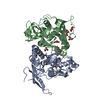

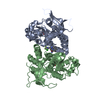
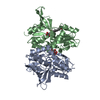
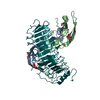
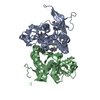
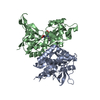

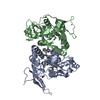
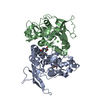
 PDBj
PDBj








